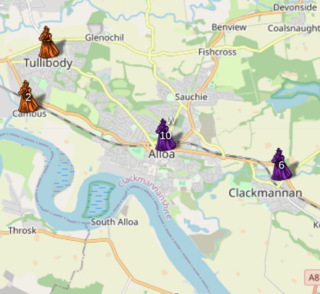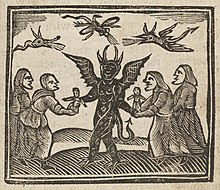
Newes from Scotland - declaring the damnable life and death of Dr. Fian, a notable sorcerer is a pamphlet printed in London in 1591, and likely written by James Carmichael, who later advised King James VI on the writing of his book Daemonologie. It describes the North Berwick witch trials in Scotland and the confessions given before the king, and was published in Daemonologie by King James in 1597.
Marie Lamont, also referred to as Mary Lawmont (1646–1662), was executed for witchcraft during the reign of Charles II just after Witchmania had peaked in the United Kingdom. Her youth at the time of her execution made her case unusual.

Beatrix Leslie was a Scottish midwife executed for witchcraft. In 1661 she was accused of causing the collapse of a coal pit through witchcraft. Little is known about her life before that, although there are reported disputes with neighbours that allude to a quarrelsome attitude.
Margaret Burges, also known as 'Lady Dalyell', was a Scottish businesswoman from Nether Cramond who was found guilty of witchcraft and executed in Edinburgh in 1629.
Bessie Wright was a healer in Perthshire who was accused of witchcraft in 1611, 1626 and then again in 1628.
Alison Pearson was executed for witchcraft. On being tried in 1588, she confessed to visions of a fairy court.

Lilias Adie was a Scottish woman who lived in the coastal village of Torryburn, Fife, Scotland. She was accused of practising witchcraft and fornicating with the devil but died in prison before sentence could be passed. Her intertidal grave is the only known one in Scotland of an accused witch – most were burned.
Julian Goodare is a professor of history at University of Edinburgh.
Louise Yeoman is a historian and broadcaster specialising in the Scottish witch hunts and 17th century Scottish religious beliefs.
The Witches of Bo'ness were a group of women accused of witchcraft in Bo'ness, Scotland in the late 17th century and ultimately executed for this crime. Among the more famous cases noted by historians, in 1679, Margaret Pringle, Bessie Vickar, Annaple Thomsone, and two women both called Margaret Hamilton were all accused of being witches, alongside "warlock" William Craw. The case of these six was "one of the last multiple trials to take place for witchcraft" in Scotland.
Margaret Barclay, was an accused witch put on trial in 1618, 'gently' tortured, confessed and was strangled and burned at the stake in Irvine, Scotland. Her case was written about with horror by the romantic novelist Sir Walter Scott, and in the 21st century, a campaign for a memorial in the town and for a pardon for Barclay and other accused witches was raised in the Scottish Parliament.
Witches of Scotland was a campaign for legal pardons and historic justice for the people, primarily women, convicted of witchcraft and executed in Scotland between 1563 and 1736. A formal apology was made on 8 March 2022. The aim was also to establish a national memorial for the convicted from the Scottish parliament.

Margaret Duchill was a Scottish woman who confessed to witchcraft at Alloa during the year 1658. She was implicated by others and she named other women. She was executed on 1 June 1658.
George and Lachlan Rattray were accused of witchcraft in Inverness. They were apprehended in 1704, allegedly guilty of "the horrid crimes of mischievous charms, by witchcraft and malefice, sorcery or necromany". They were tried locally under a commission from the Lords of the Privy Council, and sentenced to execution in the January of 1706.
Katherine Campbell was a maidservant accused of theft and witchcraft during the last major witch hunt in Scotland, the Paisley witch trials.
Issobell Fergussone or Isobel Ferguson was a Scottish woman who confessed to witchcraft in Dalkeith, Edinburgh during the year 1661.
Bessie Stivenson or Bessie Stevenson was executed for witchcraft in Stirling, Scotland in the 17th century.
Anna Tait or Anne Tait, also known as 'Hononni', was accused of witchcraft in Haddington, East Lothian in 1634 and executed in 1635. Her case revolved around her feelings of grief and guilt which caused her suicidal thoughts for the murder of her first husband and the death of her beloved daughter following a botched home abortion.

Beatrix Watsone was accused of witchcraft in 1649 at Corstorphine Parish Church, Edinburgh, and died of suicide before trial.
Isobel Elliot, sometimes called Isobell Eliot, was a woman accused of witchcraft from Peaston, near Ormiston in East Lothian. She was tried as a witch in Edinburgh during 1678, and executed on 20 September 1678 at Peaston by being strangled and burnt at the stake.




